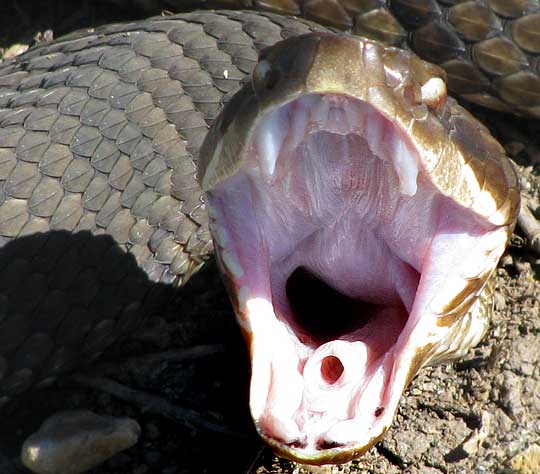Above the most striking adaptation is one that -- if you're lucky -- you'll only see behind glass or with magnification from a distance. At the bottom of this venomous Cottonmouth's mouth, notice the fleshy, cylindrical tube leading down the snake's throat. That's the glottis, or breathing tube, which comes in handy when swallowing prey so large that it blocks the throat, shutting off air. As the prey slides toward the stomach, blocking the passage of air through the throat, the glottis slips to one side and may extend out the side of the mouth, enabling the snake to breathe through the tube, snorkeler-like.
The two sharp fangs atop the Cottonmouth's mouth show another adaptation: They are slanted backwards, toward the throat, making it easier for prey to slide into the snake than squirm out of it. Cottonmouth fangs have another adaptation not shown in the picture: They're hollow.
![head of immature Rat Snake, ELAPHE [PANTHEROPHIS] OBSOLETA](snakehed.jpg) They work like hypodermic needles, with venom being injected into the prey through the hollow channels. Not all venomous snakes have hollow fangs, or even not-hollow ones. Venomous coral snakes, for example have numerous small teeth with which they chew into their victim, cutting the skin so their venom can enter the body. The snake head shown above is of an immature Rat Snake, Elaphe obsoleta with small, throat-directed teeth on the lower jaw.
They work like hypodermic needles, with venom being injected into the prey through the hollow channels. Not all venomous snakes have hollow fangs, or even not-hollow ones. Venomous coral snakes, for example have numerous small teeth with which they chew into their victim, cutting the skin so their venom can enter the body. The snake head shown above is of an immature Rat Snake, Elaphe obsoleta with small, throat-directed teeth on the lower jaw.
Most snake adaptations aren't as flashy as these, though. A snake's main adaptation is its very form. With no legs, arms, ears and other appendages, it can slither through grass or among rocks without causing disturbance that might frighten prey. It can enter narrow holes in the ground made by rodents, find those rodents and eat them. If you think that having no legs causes mobility problems for a snake, you've never seen how fast a snake can move in most environments.
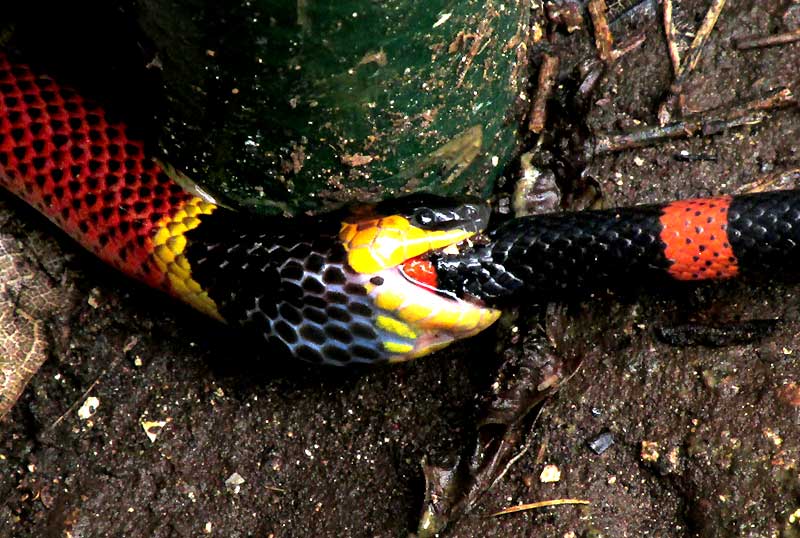
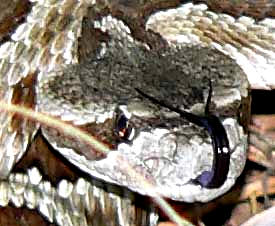 As the picture of the Western Rattlesnake at the right shows, snakes have forked tongues, which they flick from their mouths quite often. This tongue-flicking is actually the manner by which the snake "smells" its surroundings. When the tongue is outside its mouth, odor particles stick to it. Then the tongue is withdrawn into the mouth and inserted into a special section of the nasal cavity called the Jacobson's organ, where the odor is sensed.
As the picture of the Western Rattlesnake at the right shows, snakes have forked tongues, which they flick from their mouths quite often. This tongue-flicking is actually the manner by which the snake "smells" its surroundings. When the tongue is outside its mouth, odor particles stick to it. Then the tongue is withdrawn into the mouth and inserted into a special section of the nasal cavity called the Jacobson's organ, where the odor is sensed.
In recent years, Kurt Schwenk and others at the University of Connecticut have published papers documenting the advantages of a snake's constantly flicking, forked tongue. Basically, each tip of the odor-molecule-collecting forked tongue delivers information about what molecules are being collected to its own "vomeronasal organ," which independently stimulates a part of the brain that produces a "stereo smell" similar to how input from two eyes results in stereo vision. The tongue's flicking action creates vortexes of air that jet odor molecules to the tip of each tongue, where they are "smelled." The snake's tongue is simply a majestic eample of evolutionary perfection.
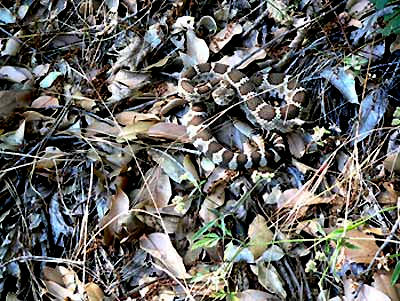
Snakes come in an incredible variety of colors and patterns. As is the case with the Western Rattlesnake, Crotalus viridis, shown above, often the colors and patterns serve to camouflage the snake. Other times bright colors and patterns make the snake more clearly visible, so that other animals will see it and stay away.
Other adaptations are peculiar to individual groups of snakes or species. Rattlesnakes have rattles on their tail that can be shaken to make a very loud and disconcerting warning sound. North America's two members of the Slender Blind Snake Family burrow beneath the ground feeding largely on termites and ants, and have no eyes which could get dirt in them and aren't useful underground anyway. Common Garter Snakes are equipped with glands that exude a very smelly substance when the snake is disturbed.
Some of the most interesting snake adaptations are behavioral, as shown below:
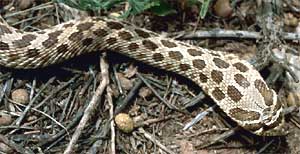
The above snake is rather common North American, the Western Hognose Snake, Heterodon nasicus. Though hognose snakes are about as harmless as snakes get, as the picture shows, they can spread their heads so that they look much larger than they are. Moreover, as they do this, they hiss! If this doesn't scare you away, suddenly they'll change strategies. They'll flip onto their backs and with their mouths wide open writhe pitifully, as if having convulsions. Then they'll just lie there, looking dead as can be. But if you sit down next to them and be quiet, in a few minutes they'll raise their head, look around and, if it looks safe, slither away!
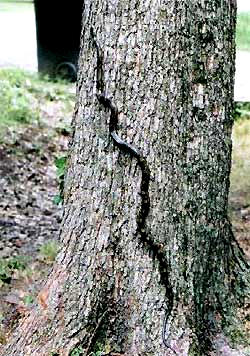 At the left you see an extraordinary adaptation of one of eastern North America's most common snakes, the Rat Snake, Elaphe obsoleta. Rat Snakes can climb right up tree trunks! They do this because their food includes birds and eggs. How do Rat Snakes climb trees? If you hold a Rat Snake you will see that in cross section it is shaped like a loaf of bread -- a rounded top with straight sides meeting the flat bottom at more or less right angles. Those squared sides pressed against a tree's bark irregularities give the snake a bit of hold, kind of like a tire with a good tread holds to the road better than a smooth tire. But it's not a very firm hold. Rat Snakes fall out of trees a lot, and that can be very surprising if you happen to be daydreaming below!
At the left you see an extraordinary adaptation of one of eastern North America's most common snakes, the Rat Snake, Elaphe obsoleta. Rat Snakes can climb right up tree trunks! They do this because their food includes birds and eggs. How do Rat Snakes climb trees? If you hold a Rat Snake you will see that in cross section it is shaped like a loaf of bread -- a rounded top with straight sides meeting the flat bottom at more or less right angles. Those squared sides pressed against a tree's bark irregularities give the snake a bit of hold, kind of like a tire with a good tread holds to the road better than a smooth tire. But it's not a very firm hold. Rat Snakes fall out of trees a lot, and that can be very surprising if you happen to be daydreaming below!

